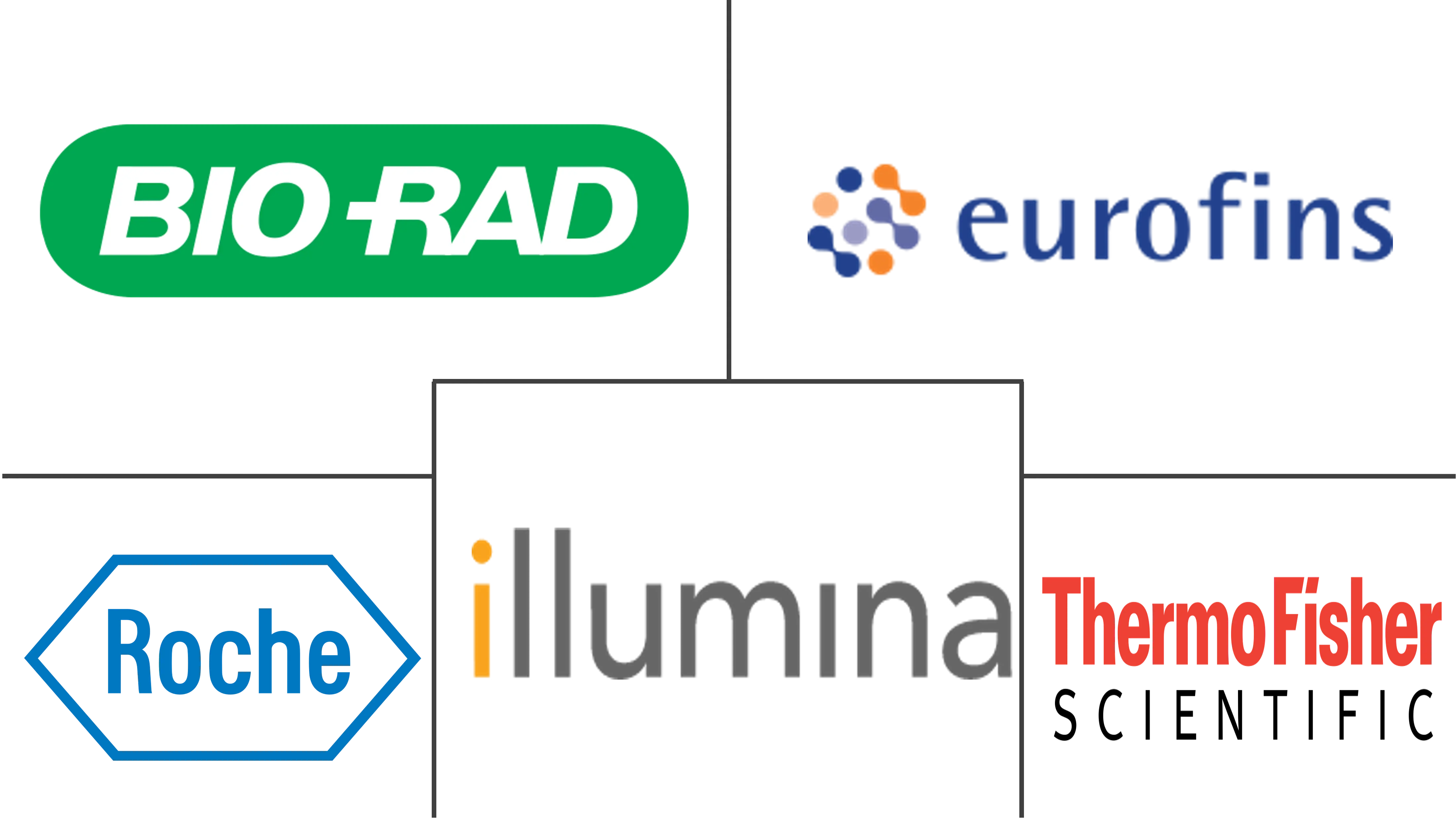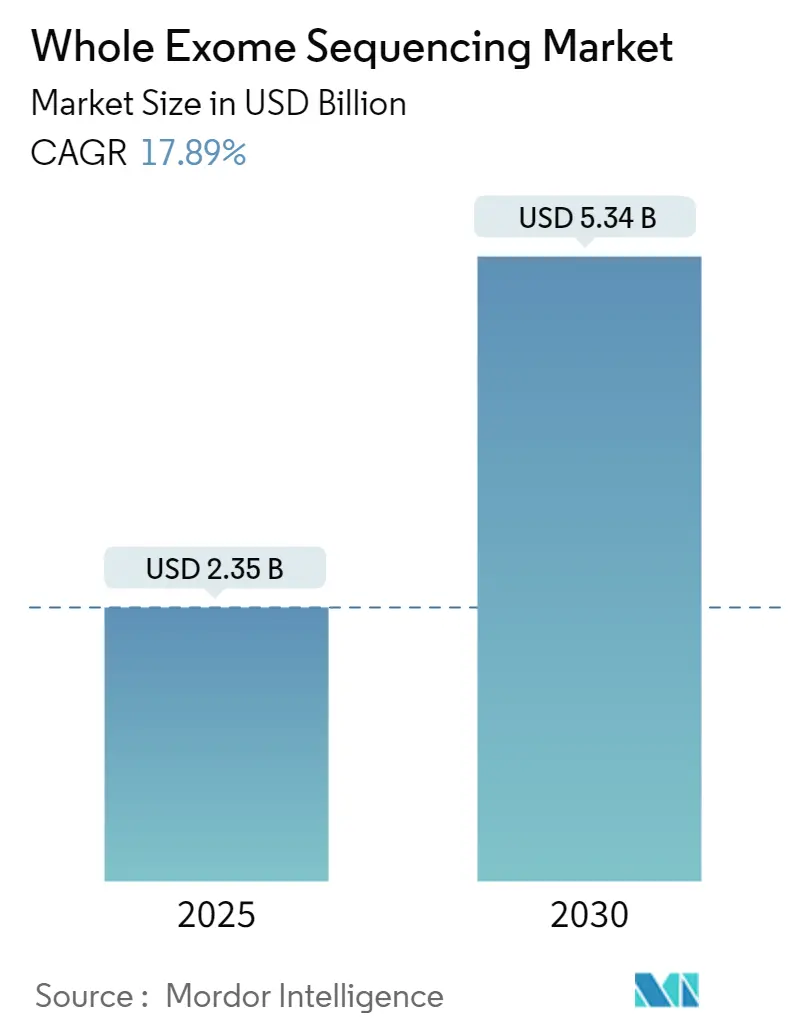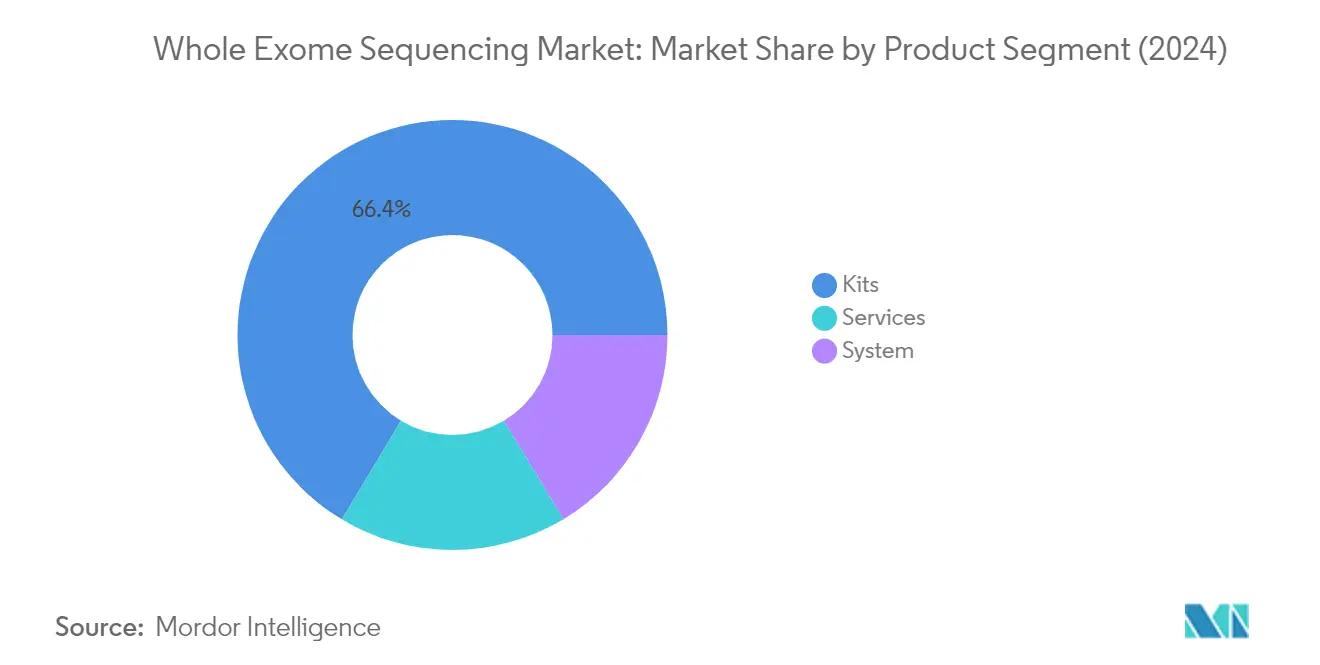Whole Exome Sequencing Market Analysis
The Whole Exome Sequencing Market size is estimated at USD 2.35 billion in 2025, and is expected to reach USD 5.34 billion by 2030, at a CAGR of 17.89% during the forecast period (2025-2030).
The whole exome sequencing industry is experiencing transformative growth driven by technological advancements and expanding applications across healthcare sectors. Leading institutions are launching large-scale genomic sequencing initiatives, exemplified by the UK Biobank's completion of exome sequencing for over 470,000 participants in 2022, establishing the world's largest such database. These initiatives are complemented by innovative platform launches, such as NanoString Technologies' new cloud-based workflow in 2023, which enhances spatial data analysis capabilities for next-generation sequencing systems. The convergence of advanced technologies and institutional support is reshaping the industry's landscape, enabling more efficient and comprehensive genetic analysis.
The market is witnessing a significant shift towards clinical applications, particularly in reproductive health and genetic disorder diagnosis. This trend is evidenced by the launch of innovative solutions like iGene Laboratory's FetalExome test in 2023, specifically designed for women with potentially complicated pregnancies. Healthcare institutions are increasingly integrating whole exome sequencing into their standard diagnostic protocols, recognizing its value in identifying genetic variations and guiding treatment decisions. The technology's ability to analyze approximately 20,000 genes simultaneously has made it an indispensable tool in modern healthcare settings, advancing precision medicine and clinical genomics.
Global health organizations and research institutions are expanding their sequencing capabilities to address various health challenges. According to the World Health Organization, approximately 39.9 million people were living with HIV globally in 2023, highlighting the growing need for advanced genomic sequencing in understanding and treating complex diseases. This has led to increased collaboration between healthcare providers and technology developers, as demonstrated by the partnership between Mount Sinai Health System and the Regeneron Genetics Center for comprehensive genomic research.
The industry is experiencing rapid technological evolution, with companies focusing on improving data analysis capabilities and workflow efficiency. A notable development is QIAGEN's launch of the enhanced QIAGEN CLC Genomics Workbench Premium in 2023, which significantly reduces data analysis bottlenecks in next-generation sequencing. Similarly, Singapore's Precision Health Research initiative, announced in 2022, aims to sequence the genomes of over 100,000 Singaporeans, demonstrating the growing focus on population-scale genomic studies. These developments are complemented by improvements in automation, artificial intelligence integration, and data interpretation tools, making whole exome sequencing more accessible and practical for clinical sequencing and molecular diagnostics applications.
Whole Exome Sequencing Market Trends
Increasing Applications in Clinical Diagnosis and Growing Demand for the Diagnosis of Rare Diseases
The technique of whole exome sequencing (WES) has emerged as a crucial tool in clinical diagnosis, particularly for identifying novel disease genes and pathways across various conditions, including autism, epilepsy, brain abnormalities, congenital heart disease, and neurodevelopmental impairments. According to the Genetic and Rare Diseases (GARD) Information Center's 2022 data, approximately 1 in 10 Americans (or 30 million people) have a rare disease, with around 7,000 known rare diseases currently identified. The significant burden of rare diseases, with about 300 million people worldwide affected, has created an urgent need for effective rare disease diagnostics solutions, driving the adoption of WES in clinical settings.
Medical professionals are increasingly leveraging WES to detect hidden phenotypes and the pathophysiology of extremely rare neurogenetic illnesses, ultimately leading to more successful treatment outcomes. The technology's effectiveness in clinical diagnosis is particularly evident in epilepsy cases, where it serves as a crucial tool for both diagnosis and prognosis understanding. This is especially significant given the World Health Organization's 2022 data indicating that approximately 50 million people worldwide have epilepsy, with high-income countries recording about 49 per 100,000 new patients annually, while low- and middle-income countries see rates as high as 139 per 100,000.
Increasing R&D in the Field of Genomics and Next-Generation Sequencing
The research-based biopharmaceutical industry's commitment to innovation has led to significant investments in genomics and next-generation sequencing research. In August 2022, Mount Sinai Health System and the Icahn School of Medicine at Mount Sinai launched the groundbreaking Mount Sinai Million Health Discoveries Program in collaboration with the Regeneron Genetics Center (RGC). This initiative represents a significant advancement in human genome sequencing research, demonstrating the industry's commitment to expanding genomic research capabilities. Additionally, the South Korean government's investment of over USD 55.7 million in developing genetic testing-based treatments in 2022 exemplifies the global commitment to advancing genomic research and applications.
The field continues to see remarkable developments in 2023, as evidenced by QIAGEN Digital Insights' enhancement of their QIAGEN CLC Genomics Workbench Premium, which has revolutionized the analysis speed for whole exome sequencing data. This advancement addresses the critical need for efficient data analysis in genomic research. Furthermore, strategic partnerships and investments continue to drive innovation in the field, as demonstrated by Illumina's 2023 Global Health Access Initiative, which aims to expand access to sequencing applications in low- and middle-income countries, covering various applications from drug resistance profiling to pathogen detection and surveillance.
Increasing Demand for Personalized Medicine
The growing emphasis on precision medicine has become a significant driver for whole exome sequencing adoption, as healthcare providers increasingly recognize the value of tailoring treatments to individual patient characteristics. The potential use of WES in precision medicine is vast and necessary for effective implementation in clinical settings, with its speed, accuracy, and increasing affordability helping to accelerate the advent of precision medicine. According to the Personalized Medicine Coalition (PMC), personalized medicines accounted for over a third of new drug approvals in 2021, demonstrating the growing importance of targeted therapeutic approaches in modern healthcare.
The integration of WES in precision medicine continues to expand through strategic initiatives and technological advancements. In 2023, significant developments have emerged, such as the Medical Device Innovation Consortium's pilot project under its Somatic Reference Sample (SRS) Initiative, which aims to enhance the validation and regulatory review processes for cancer diagnostics utilizing next-generation sequencing. The benefits of this approach are particularly evident in cancer treatment, where WES enables healthcare providers to design treatments based on a patient's disease-driving molecular alterations. This capability has led to increased adoption in clinical settings, supported by developments such as Singapore-based iGene Laboratory's launch of the FetalExome test service in February 2023, which demonstrates the expanding applications of WES in personalized healthcare solutions.
Segment Analysis: By Product
Kits Segment in Whole Exome Sequencing Market
The kits segment continues to dominate the whole exome sequencing market, holding approximately 66% of the total market share in 2024. This significant market position is primarily driven by the increasing application of kits in clinical sequencing and the rising demand for diagnosing rare diseases. The segment's growth is further supported by continuous product innovations and launches by key market players. For instance, in January 2023, QIAGEN Digital Insights enhanced its QIAGEN CLC Genomics Workbench Premium to improve the analysis speed of whole exome sequencing data. Additionally, the cost-effectiveness and efficiency of exome sequencing kits compared to other methods have contributed to their widespread adoption across research institutions and clinical laboratories.
Services Segment in Whole Exome Sequencing Market
The services segment is emerging as the fastest-growing segment in the whole exome sequencing market, with a projected growth rate of approximately 19% during 2024-2029. This remarkable growth is attributed to the increasing demand for specialized sequencing services among healthcare providers and research institutions. The expansion of service offerings by major market players and the growing trend of outsourcing sequencing services have significantly contributed to this segment's growth. For example, in February 2023, Singapore-based molecular diagnostics lab group iGene Laboratory launched the FetalExome test service for women with potentially complicated pregnancies, demonstrating the expanding scope of whole exome sequencing services.
Remaining Segments in Product Segmentation
The system segment represents a crucial component of the whole exome sequencing market, providing the fundamental infrastructure required for sequencing operations. This segment encompasses various sequencing platforms and instruments essential for conducting whole exome sequencing procedures. The segment's growth is driven by technological advancements in sequencing systems, improved accuracy and efficiency of newer platforms, and the increasing adoption of automated sequencing systems in research and clinical settings. The continuous development of more sophisticated and user-friendly systems by manufacturers has made whole exome sequencing more accessible to a broader range of users.
Segment Analysis: By Technology
Second-Generation Sequencing Segment in Whole Exome Sequencing Market
Second-generation sequencing technology continues to dominate the whole exome sequencing market, holding approximately 62% of the market share in 2024. This significant market position is attributed to its widespread adoption in diagnostic sequencing and research applications, particularly in identifying genetic variations associated with rare diseases and cancer. The technology's high throughput capabilities, improved accuracy, and relatively lower cost per base compared to traditional sequencing methods have made it the preferred choice for many healthcare institutions and research facilities. Major market players have been actively developing and launching advanced second-generation sequencing platforms with enhanced features, contributing to the segment's sustained leadership. The technology's ability to process multiple DNA sequencing samples simultaneously while maintaining high accuracy has been particularly valuable in large-scale genomic studies and clinical applications.
Third-Generation Sequencing Segment in Whole Exome Sequencing Market
The third-generation sequencing segment is emerging as the fastest-growing technology in the whole exome sequencing market, projected to grow at approximately 18% from 2024 to 2029. This rapid growth is driven by the technology's ability to produce substantially longer reads than second-generation sequencing, offering improved resolution for complex genomic regions. The technology's faster sequencing speed compared to second-generation techniques makes it particularly valuable in clinical settings, especially for rapid pathogen identification and diagnosis. Recent technological advancements have addressed earlier limitations in accuracy and cost, making third-generation sequencing increasingly attractive for both research and clinical applications. The segment's growth is further supported by ongoing innovations in long-read sequencing technologies and their expanding applications in studying genetic variations and structural variants.
Segment Analysis: By Application
Diagnostics Segment in Whole Exome Sequencing Market
The diagnostics segment continues to dominate the whole exome sequencing market, holding approximately 38% market share in 2024. This significant market position is primarily driven by the increasing applications of whole exome sequencing in genetic testing and the growing demand for diagnosing rare diseases. The technique has proven particularly valuable in identifying genetic variations associated with various disorders, making it an essential tool for healthcare providers. The segment's growth is further supported by its high diagnostic yield in detecting genetic disorders, especially in cases where conventional diagnostic methods have failed to provide conclusive results. Additionally, the increasing adoption of exome sequencing in prenatal diagnostics and the rising prevalence of chronic neurological rare diseases have contributed to the segment's market leadership.
Drug Discovery and Development Segment in Whole Exome Sequencing Market
The drug discovery and development segment is emerging as the fastest-growing segment in the whole exome sequencing market, with a projected growth rate of approximately 19% from 2024 to 2029. This remarkable growth is attributed to the increasing utilization of whole exome sequencing in pharmaceutical research and development processes. The segment's expansion is driven by the rising demand for targeted therapeutics and the growing need for understanding genetic variations in drug response. The technology's ability to identify drug resistance and predict response to medical interventions has made it an invaluable tool in the pharmaceutical industry. Furthermore, the integration of whole exome sequencing in drug development processes has significantly enhanced the efficiency of identifying potential drug targets and understanding disease mechanisms at the molecular level.
Remaining Segments in Application Market Segmentation
The personalized medicine and other applications segments also play crucial roles in shaping the whole exome sequencing market landscape. The personalized medicine segment is gaining significant traction due to the increasing focus on tailored therapeutic approaches and the growing demand for precision medicine solutions. This segment is particularly important in developing patient-specific treatment strategies and understanding individual genetic profiles for better healthcare outcomes. The other applications segment, which includes areas such as agriculture and animal research, demonstrates the versatility of whole exome sequencing technology beyond human healthcare applications. These segments collectively contribute to the market's diversification and highlight the broad applicability of whole exome sequencing across various fields.
Whole Exome Sequencing Market Geography Segment Analysis
Whole Exome Sequencing Market in North America
The North American whole exome sequencing market demonstrates robust growth driven by advanced healthcare infrastructure, increasing research and development activities in genomics, and rising demand for precision medicine. The United States leads the regional market, followed by Canada and Mexico. The region benefits from the presence of major market players, extensive research facilities, and favorable regulatory frameworks that support the adoption of advanced genomic sequencing technologies. Healthcare institutions across these countries are increasingly incorporating whole exome sequencing for clinical diagnosis, particularly in rare diseases and cancer research.
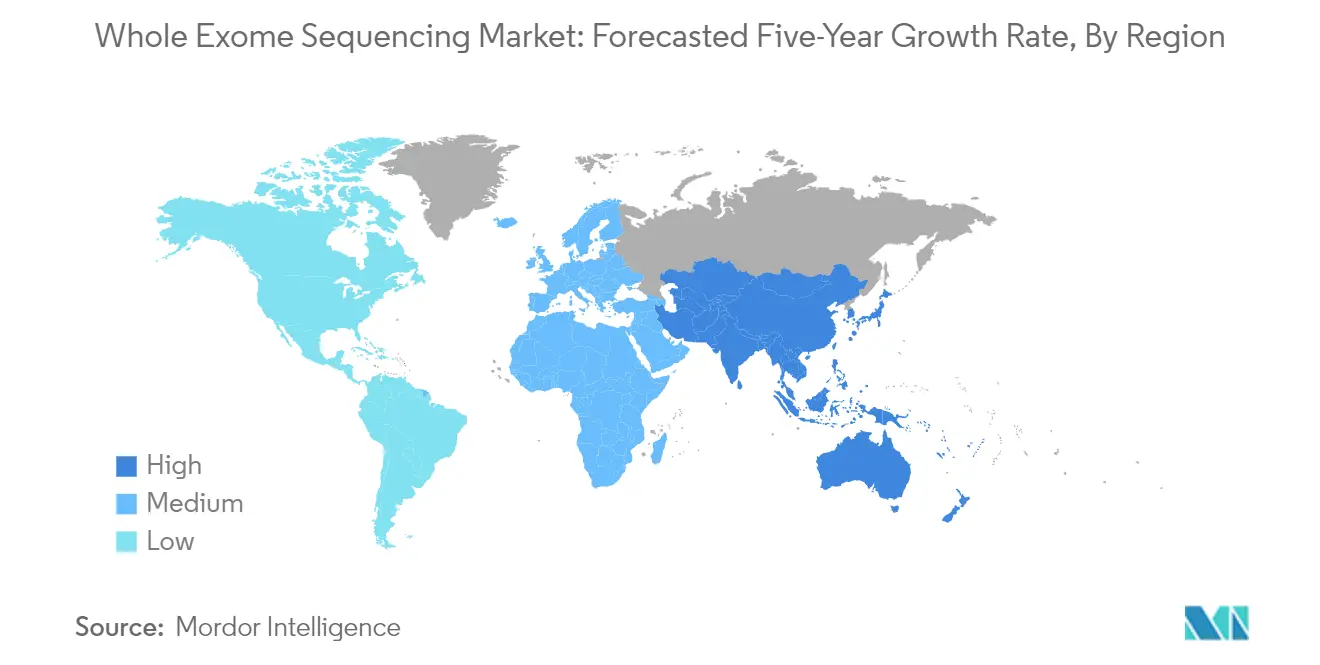
Whole Exome Sequencing Market in the United States
The United States dominates the North American market with approximately 80% market share in the region. The country's leadership position is strengthened by significant healthcare spending, growing company and government initiatives to promote genetic testing, and rising product launches. The presence of leading biotechnology companies and research institutions has created a robust ecosystem for clinical genomics research and applications. The high adoption of precision medicine approaches, coupled with increasing applications in clinical diagnosis and growing demand for rare disease diagnosis, continues to drive market growth. The country also benefits from advanced healthcare infrastructure and increasing integration of genomic medicine in routine clinical practice.
Whole Exome Sequencing Market in Mexico
Mexico emerges as a promising market in North America with an expected growth rate of approximately 17% during 2024-2029. The country is positioning itself as an attractive market with fewer regulatory challenges compared to advanced countries. The increasing applications of exome sequencing in clinical diagnosis, growing research and development in genomics, and rising demand for precision medicines are driving market growth. Mexican healthcare institutions are increasingly adopting whole exome sequencing for various applications, particularly in research studies and clinical diagnostics. The country's improving research infrastructure and growing focus on genetic testing services contribute to market expansion.
Whole Exome Sequencing Market in Europe
The European whole exome sequencing market exhibits strong growth potential supported by extensive research activities, advanced healthcare systems, and increasing adoption of precision medicine approaches. The region encompasses key markets including Germany, the United Kingdom, France, Italy, and Spain, each contributing significantly to market development. The presence of well-established healthcare infrastructure, research institutions, and biotechnology companies drives market growth. European countries demonstrate strong commitment to genomic research and its clinical applications, supported by various national initiatives and research programs.
Whole Exome Sequencing Market in Germany
Germany maintains its position as the largest market in Europe, holding approximately 26% of the regional market share. The country's market leadership is driven by the increasing burden of cancer, growing prevalence of genetic diseases, and extensive company activities in the sector. German healthcare institutions demonstrate high adoption rates of advanced genomic sequencing technologies, supported by robust research infrastructure and healthcare spending. The country's strong focus on precision medicine and genetic research, coupled with the presence of leading biotechnology companies, continues to drive market growth.
Whole Exome Sequencing Market in France
France emerges as the fastest-growing market in Europe with an anticipated growth rate of approximately 20% during 2024-2029. The country's market is characterized by the rising prevalence of cancer, diabetes, genetic diseases, and other chronic conditions, driving demand for advanced diagnostic solutions. French healthcare institutions are increasingly adopting exome sequencing in clinical diagnosis, supported by high demand for precision medicine and growing company activities. The country's strong research infrastructure and focus on genomic medicine contribute significantly to market expansion.
Whole Exome Sequencing Market in Asia-Pacific
The Asia-Pacific whole exome sequencing market demonstrates significant growth potential driven by improving healthcare infrastructure, increasing research activities, and rising adoption of advanced diagnostic technologies. The region encompasses diverse markets including China, Japan, India, Australia, and South Korea, each contributing uniquely to market development. Growing investments in genomic research, rising prevalence of genetic disorders, and increasing healthcare expenditure support market expansion across the region.
Whole Exome Sequencing Market in China
China leads the Asia-Pacific market as the largest country in terms of market size. The country's dominance is supported by active research and clinical use of whole exome sequencing in disease diagnosis and early prediction of cancer. The Chinese market benefits from significant investments in genomic research, improving healthcare infrastructure, and the presence of major industry players. The country's focus on precision medicine and genetic research, coupled with expanding clinical applications, drives market growth.
Whole Exome Sequencing Market in India
India emerges as the fastest-growing market in the Asia-Pacific region. The country's market growth is driven by advancing research in whole-exome sequencing for clinical purposes and improving research infrastructure. Indian healthcare institutions are increasingly adopting genomic technologies for clinical diagnosis and research applications. The country's growing focus on precision medicine, coupled with rising investments in healthcare infrastructure and research facilities, supports market expansion.
Whole Exome Sequencing Market in the Middle East & Africa
The Middle East & Africa whole exome sequencing market shows promising growth potential, with GCC countries and South Africa as key contributors. The region's market is driven by increasing investment in genomics, growing demand for rare disease diagnosis, and rising adoption of precision medicine approaches. GCC emerges as the largest market in the region, while South Africa demonstrates significant growth potential. The region's improving healthcare infrastructure and increasing focus on advanced diagnostic technologies support market development.
Whole Exome Sequencing Market in South America
The South American whole exome sequencing market demonstrates steady growth, with Brazil and Argentina as primary contributors. The region's market development is supported by increasing research activities, growing adoption of advanced diagnostic technologies, and rising focus on precision medicine. Brazil emerges as the largest market in the region, while Argentina shows promising growth potential. The region's improving healthcare infrastructure and increasing investments in genomic research contribute to market expansion.
Whole Exome Sequencing Industry Overview
Top Companies in Whole Exome Sequencing Market
The whole exome sequencing market is characterized by intense innovation and strategic developments among key players, including Illumina, Thermo Fisher Scientific, QIAGEN, and Roche. Companies are focusing on developing advanced genomic sequencing platforms with improved accuracy and reduced turnaround times, while simultaneously expanding their genomic services portfolio. Strategic collaborations with research institutions and healthcare providers have become increasingly common to enhance market presence and technological capabilities. Market leaders are investing heavily in research and development to introduce new products and services, particularly in areas like precision medicine and rare disease diagnostics. The industry has witnessed a significant push towards developing integrated solutions that combine sequencing hardware with sophisticated data analysis tools and bioinformatics platforms.
Consolidated Market with Strong Global Players
The whole exome sequencing market demonstrates a relatively consolidated structure dominated by large multinational corporations with extensive research capabilities and global distribution networks. These established players have built strong market positions through their comprehensive product portfolios, established brand recognition, and significant investments in technological advancement. The market has witnessed strategic acquisitions and partnerships, particularly targeting companies with complementary technologies or regional market access. Many of these dominant players are diversified life sciences companies that leverage their broader healthcare and diagnostics expertise to strengthen their position in the whole exome sequencing segment.
The competitive dynamics are further shaped by the presence of specialized genomics companies and regional players who focus on specific applications or geographical markets. These companies often compete through specialized expertise, customized solutions, and strong local relationships. The market has seen increased collaboration between established players and emerging companies, particularly in developing integrated solutions that combine sequencing capabilities with advanced data analysis and interpretation tools. The industry structure encourages continuous innovation and technological advancement, with companies investing in both internal development and external partnerships to maintain competitive advantage.
Innovation and Integration Drive Future Success
Success in the whole exome sequencing market increasingly depends on companies' ability to provide comprehensive, integrated solutions that address the entire workflow from sample preparation to data analysis and interpretation. Market leaders are focusing on developing user-friendly platforms that can handle higher throughput while maintaining accuracy and reducing costs. The ability to provide specialized applications for different end-user segments, particularly in clinical genomics and pharmaceutical research, has become crucial for maintaining market position. Companies are also investing in building strong service and support networks to assist customers in implementing and optimizing their sequencing workflows.
Future market success will be significantly influenced by companies' ability to navigate regulatory requirements across different regions while maintaining innovation momentum. The increasing focus on precision medicine and personalized healthcare creates opportunities for companies that can effectively integrate their sequencing solutions with broader healthcare systems and workflows. Companies must also address data security and privacy concerns, particularly as genomic information becomes more integrated into clinical decision-making. The development of artificial intelligence and machine learning capabilities for data interpretation, along with the ability to offer cost-effective solutions for different market segments, will be crucial for maintaining competitive advantage in this evolving market.
Whole Exome Sequencing Market Leaders
-
Bio-Rad Laboratories Inc.
-
Eurofins Scientific Group
-
F. Hoffmann-La Roche AG
-
Illumina Inc.
-
Thermo Fisher Scientific Inc.
- *Disclaimer: Major Players sorted in no particular order
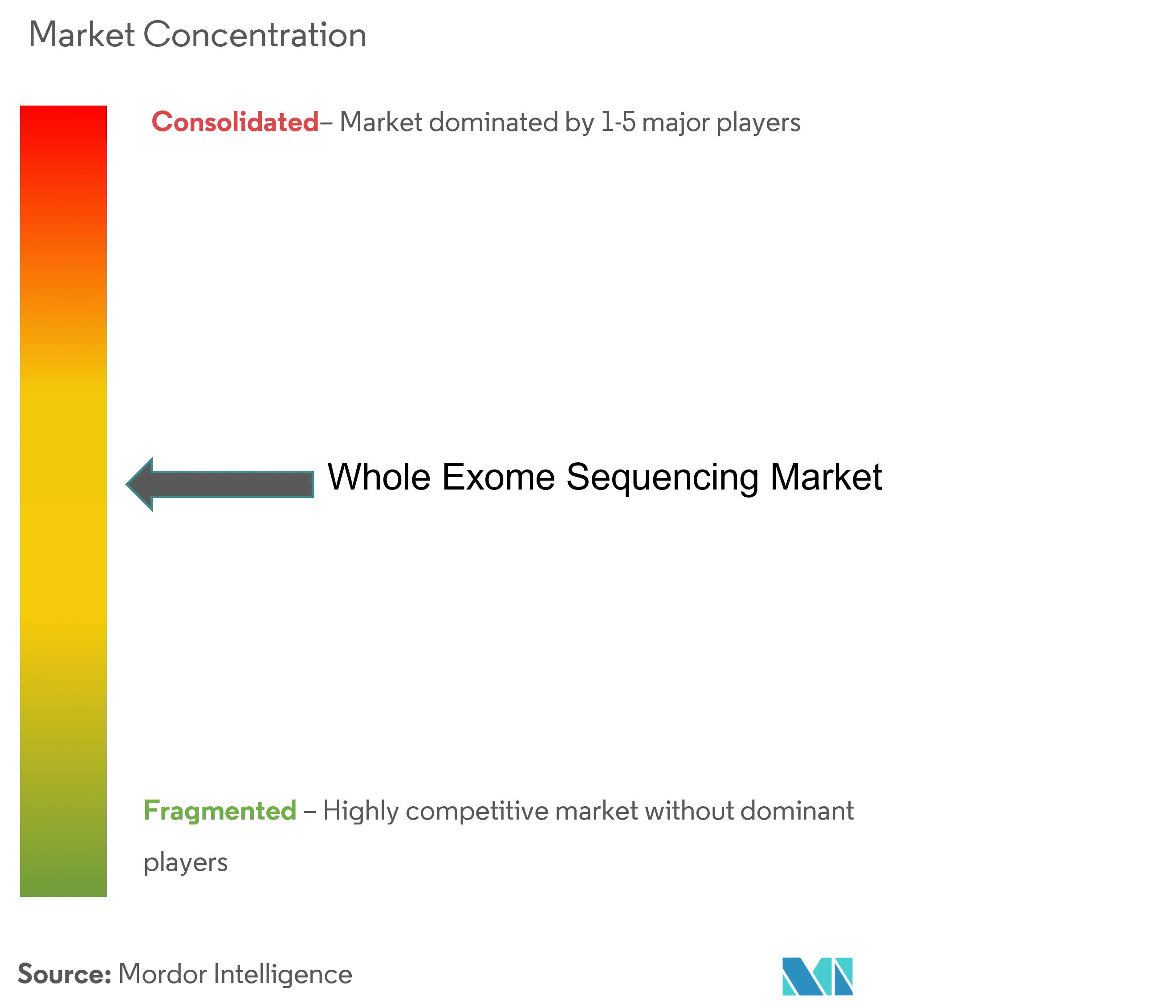
Whole Exome Sequencing Market News
- May 2024: SOPHiA GENETICS, a prominent player in data-driven medicine, partnered with tech giants Microsoft and NVIDIA to revolutionize healthcare by introducing an advanced, scalable whole genome sequencing (WGS) analytical solution. The trio aims to roll out this cutting-edge solution to healthcare providers by the year's end.
- February 2023: Illumina Inc. reported that its first NovaSeqX Plus system was delivered to the Broad Institute. The platform will support groups wanting to access the sequencing service, the company's human whole genome product, and blended genome/exome product.
Whole Exome Sequencing Market Report - Table of Contents
1. INTRODUCTION
- 1.1 Study Assumption and Market Definition
- 1.2 Scope of the Study
2. RESEARCH METHODOLOGY
3. EXECUTIVE SUMMARY
4. MARKET DYNAMICS
- 4.1 Market Overview
-
4.2 Market Drivers
- 4.2.1 Increasing Applications in the Clinical Diagnosis and Growing Demand for the Diagnosis of Rare Diseases
- 4.2.2 Increasing R&D in the Field of Genomics and Next-generation Sequencing
- 4.2.3 Increasing Demand for Personalized Medicine
-
4.3 Market Restraints
- 4.3.1 High Complexity of Technique and Lack of Skilled Personnel
- 4.3.2 Legal and Ethical Issues Associated with Whole Exome Sequencing
-
4.4 Porter's Five Forces Analysis
- 4.4.1 Threat of New Entrants
- 4.4.2 Bargaining Power of Buyers/Consumers
- 4.4.3 Bargaining Power of Suppliers
- 4.4.4 Threat of Substitute Products
- 4.4.5 Intensity of Competitive Rivalry
5. MARKET SEGMENTATION (Market Size by Value in USD)
-
5.1 By Product Type
- 5.1.1 System
- 5.1.2 Kits
- 5.1.3 Services
-
5.2 By Technology
- 5.2.1 Second-Generation Sequencing
- 5.2.1.1 Sequencing by Synthesis (SBS)
- 5.2.1.2 Sequencing by Hybridization and Ligation (SBL)
- 5.2.2 Third-generation Sequencing
-
5.3 By Application
- 5.3.1 Diagnostics
- 5.3.2 Drug Discovery and Development
- 5.3.3 Personalized Medicine
- 5.3.4 Other Applications (Agriculture, Animal Research, etc.)
-
5.4 By Geography
- 5.4.1 North America
- 5.4.1.1 United States
- 5.4.1.2 Canada
- 5.4.1.3 Mexico
- 5.4.2 Europe
- 5.4.2.1 Germany
- 5.4.2.2 United Kingdom
- 5.4.2.3 France
- 5.4.2.4 Italy
- 5.4.2.5 Spain
- 5.4.2.6 Rest of Europe
- 5.4.3 Asia-Pacific
- 5.4.3.1 China
- 5.4.3.2 Japan
- 5.4.3.3 India
- 5.4.3.4 Australia
- 5.4.3.5 South Korea
- 5.4.3.6 Rest of Asia-Pacific
- 5.4.4 Middle East and Africa
- 5.4.4.1 GCC
- 5.4.4.2 South Africa
- 5.4.4.3 Rest of Middle East and Africa
- 5.4.5 South America
- 5.4.5.1 Brazil
- 5.4.5.2 Argentina
- 5.4.5.3 Rest of South America
6. COMPETITIVE LANDSCAPE
-
6.1 Company Profiles
- 6.1.1 Konica Minolta Inc. (Ambry Genetics)
- 6.1.2 Beijing Genomics Institute
- 6.1.3 Bio-Rad Laboratories Inc.
- 6.1.4 Eurofins Scientific Group
- 6.1.5 F. Hoffmann-La Roche AG
- 6.1.6 Azenta, Inc.
- 6.1.7 Illumina Inc.
- 6.1.8 Psomagen Inc. (Macrogen Inc.)
- 6.1.9 PerkinElmer Inc.
- 6.1.10 Thermo Fisher Scientific Inc.
- 6.1.11 GENEYX GENOMEX
- 6.1.12 CD Genomics
- 6.1.13 QIAGEN Inc.
- *List Not Exhaustive
7. MARKET OPPORTUNITIES AND FUTURE TRENDS
Whole Exome Sequencing Industry Segmentation
As per the scope of the report, exome sequencing is a technique for sequencing all the exome and protein-coding genes in a genome. This technique includes the selection of the subset of DNA that encodes proteins or exons, followed by sequencing of the exonic DNA using high-throughput DNA sequencing methods. It also provides a cost-effective screening approach for the diagnosis of genetic disorders. It presents itself as a less resource-intensive alternative to whole-genome sequencing in several applications, including drug discovery and development processes.
The whole exome sequencing market is segmented by product type, technology, application, and geography. By product type, the market is segmented into systems, kits, and services. By technology, the market is segmented into second-generation sequencing and third-generation sequencing. By second-generation sequencing, the market is segmented into sequencing, by synthesis (SBS) and sequencing, by hybridization and ligation (SBL). By application, the market is segmented into diagnostics, drug discovery and development, personalized medicine, and other applications. By geography, the market is segmented into North America, Europe, Asia-Pacific, the Middle East and Africa, and South America. The report offers the value (USD) for the above segments.
| By Product Type | System | ||
| Kits | |||
| Services | |||
| By Technology | Second-Generation Sequencing | Sequencing by Synthesis (SBS) | |
| Sequencing by Hybridization and Ligation (SBL) | |||
| Third-generation Sequencing | |||
| By Application | Diagnostics | ||
| Drug Discovery and Development | |||
| Personalized Medicine | |||
| Other Applications (Agriculture, Animal Research, etc.) | |||
| By Geography | North America | United States | |
| Canada | |||
| Mexico | |||
| Europe | Germany | ||
| United Kingdom | |||
| France | |||
| Italy | |||
| Spain | |||
| Rest of Europe | |||
| Asia-Pacific | China | ||
| Japan | |||
| India | |||
| Australia | |||
| South Korea | |||
| Rest of Asia-Pacific | |||
| Middle East and Africa | GCC | ||
| South Africa | |||
| Rest of Middle East and Africa | |||
| South America | Brazil | ||
| Argentina | |||
| Rest of South America | |||
Whole Exome Sequencing Market Research FAQs
How big is the Whole Exome Sequencing Market?
The Whole Exome Sequencing Market size is expected to reach USD 2.35 billion in 2025 and grow at a CAGR of 17.89% to reach USD 5.34 billion by 2030.
What is the current Whole Exome Sequencing Market size?
In 2025, the Whole Exome Sequencing Market size is expected to reach USD 2.35 billion.
Who are the key players in Whole Exome Sequencing Market?
Bio-Rad Laboratories Inc., Eurofins Scientific Group, F. Hoffmann-La Roche AG, Illumina Inc. and Thermo Fisher Scientific Inc. are the major companies operating in the Whole Exome Sequencing Market.
Which is the fastest growing region in Whole Exome Sequencing Market?
Asia-Pacific is estimated to grow at the highest CAGR over the forecast period (2025-2030).
Which region has the biggest share in Whole Exome Sequencing Market?
In 2025, the North America accounts for the largest market share in Whole Exome Sequencing Market.
What years does this Whole Exome Sequencing Market cover, and what was the market size in 2024?
In 2024, the Whole Exome Sequencing Market size was estimated at USD 1.93 billion. The report covers the Whole Exome Sequencing Market historical market size for years: 2019, 2020, 2021, 2022, 2023 and 2024. The report also forecasts the Whole Exome Sequencing Market size for years: 2025, 2026, 2027, 2028, 2029 and 2030.
Our Best Selling Reports
Whole Exome Sequencing Market Research
Mordor Intelligence provides a comprehensive analysis of the whole exome sequencing market. We leverage our extensive expertise in molecular diagnostics and genetic testing research. Our analytical framework covers the entire spectrum of genomic sequencing technologies, including NGS (Next Generation Sequencing) and DNA sequencing applications. The report offers detailed insights into clinical genomics, targeted sequencing, and precision medicine developments. We place particular emphasis on genetic diagnostics and advancements in clinical sequencing. Our research methodology combines primary data collection with rigorous market analysis. This information is available in an easy-to-download report PDF format.
The report provides stakeholders with crucial insights into the whole exome sequencing market size and emerging opportunities within the molecular diagnostics market. Industry participants benefit from our detailed analysis of genetic testing industry trends, clinical genomics market dynamics, and precision medicine industry developments. The comprehensive coverage includes an assessment of key exome sequencing companies, technological innovations in diagnostic sequencing, and applications in rare disease diagnostics. Our analysis extends to the broader NGS industry landscape, offering valuable perspectives on constitutional genetic testing and the evolution of the genetic analysis market. This enables informed decision-making for industry stakeholders.

